Eco-friendly Building: Preliminary and Detailed Design Analysis
VerifiedAdded on 2023/06/03
|15
|3046
|399
Report
AI Summary
This report analyzes the design and construction of an eco-friendly building, emphasizing sustainable practices and environmental impact reduction. The introduction summarizes the conceptual design discussed previously. The report then delves into the preliminary and detailed design phases, exploring material options like timber and discussing the importance of waterproof flooring and efficient door construction. It also covers system testing, evaluation, validation, and optimization processes, including Post Occupancy Evaluation (POE) and the use of energy software to assess building performance. The report concludes with an evaluation of the design choices and their impact on achieving eco-friendly building goals, emphasizing the importance of considering both costs and benefits in material selection and construction methods. The report highlights the importance of designing functional and secure spaces that minimize environmental impact while providing a comfortable living environment. It also emphasizes the need for continuous evaluation and optimization throughout the building's lifecycle to ensure its sustainability.
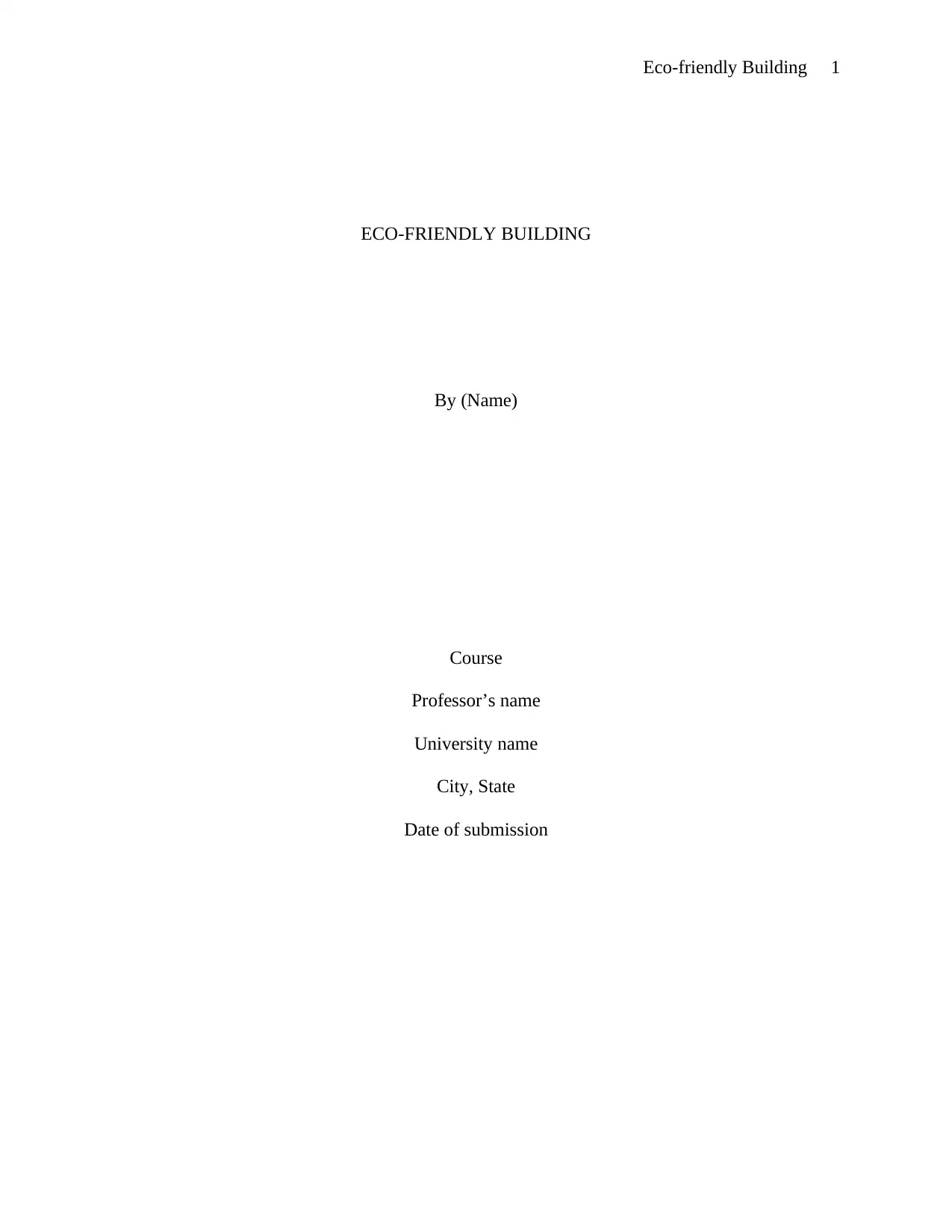
Eco-friendly Building 1
ECO-FRIENDLY BUILDING
By (Name)
Course
Professor’s name
University name
City, State
Date of submission
ECO-FRIENDLY BUILDING
By (Name)
Course
Professor’s name
University name
City, State
Date of submission
Paraphrase This Document
Need a fresh take? Get an instant paraphrase of this document with our AI Paraphraser
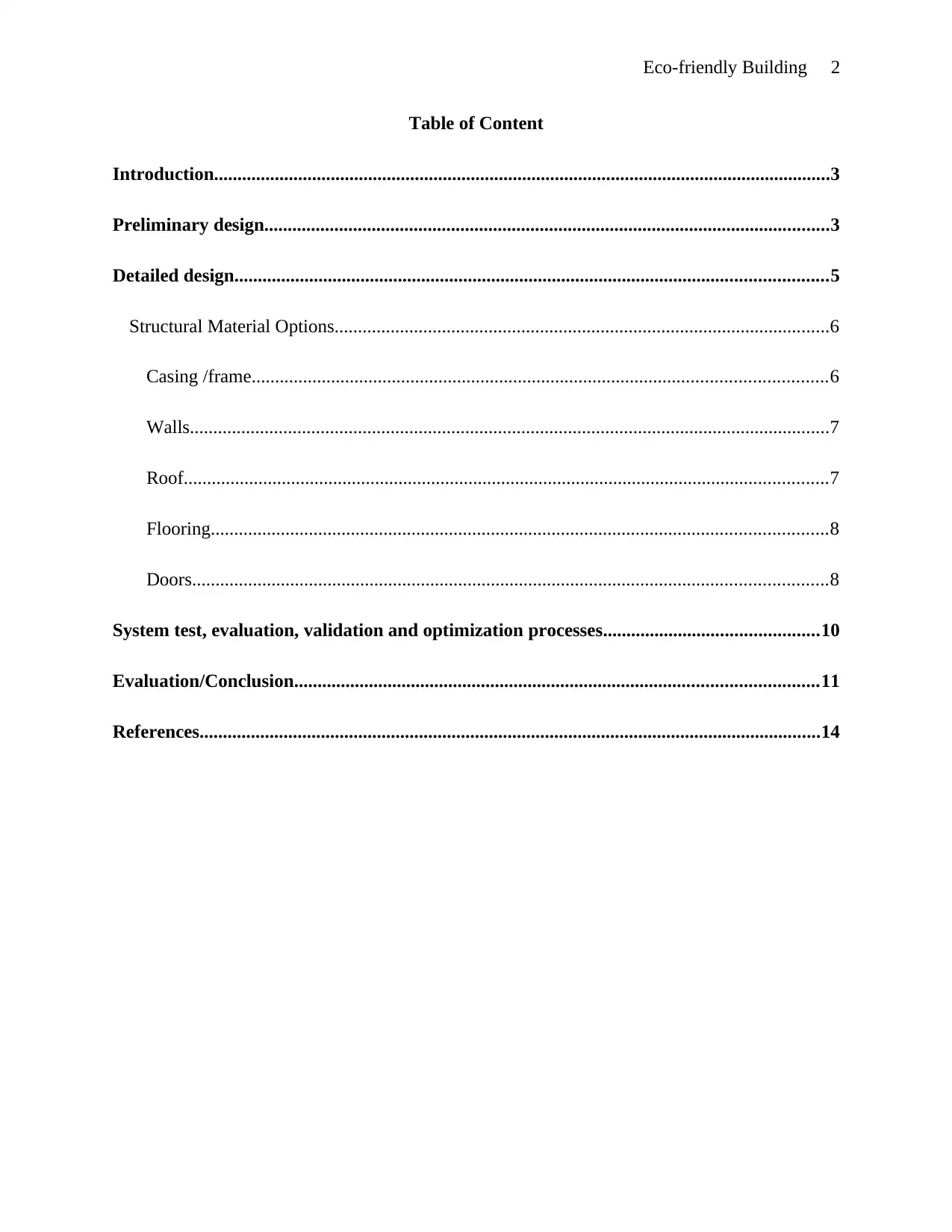
Eco-friendly Building 2
Table of Content
Introduction....................................................................................................................................3
Preliminary design.........................................................................................................................3
Detailed design...............................................................................................................................5
Structural Material Options..........................................................................................................6
Casing /frame...........................................................................................................................6
Walls.........................................................................................................................................7
Roof..........................................................................................................................................7
Flooring....................................................................................................................................8
Doors........................................................................................................................................8
System test, evaluation, validation and optimization processes..............................................10
Evaluation/Conclusion................................................................................................................11
References.....................................................................................................................................14
Table of Content
Introduction....................................................................................................................................3
Preliminary design.........................................................................................................................3
Detailed design...............................................................................................................................5
Structural Material Options..........................................................................................................6
Casing /frame...........................................................................................................................6
Walls.........................................................................................................................................7
Roof..........................................................................................................................................7
Flooring....................................................................................................................................8
Doors........................................................................................................................................8
System test, evaluation, validation and optimization processes..............................................10
Evaluation/Conclusion................................................................................................................11
References.....................................................................................................................................14
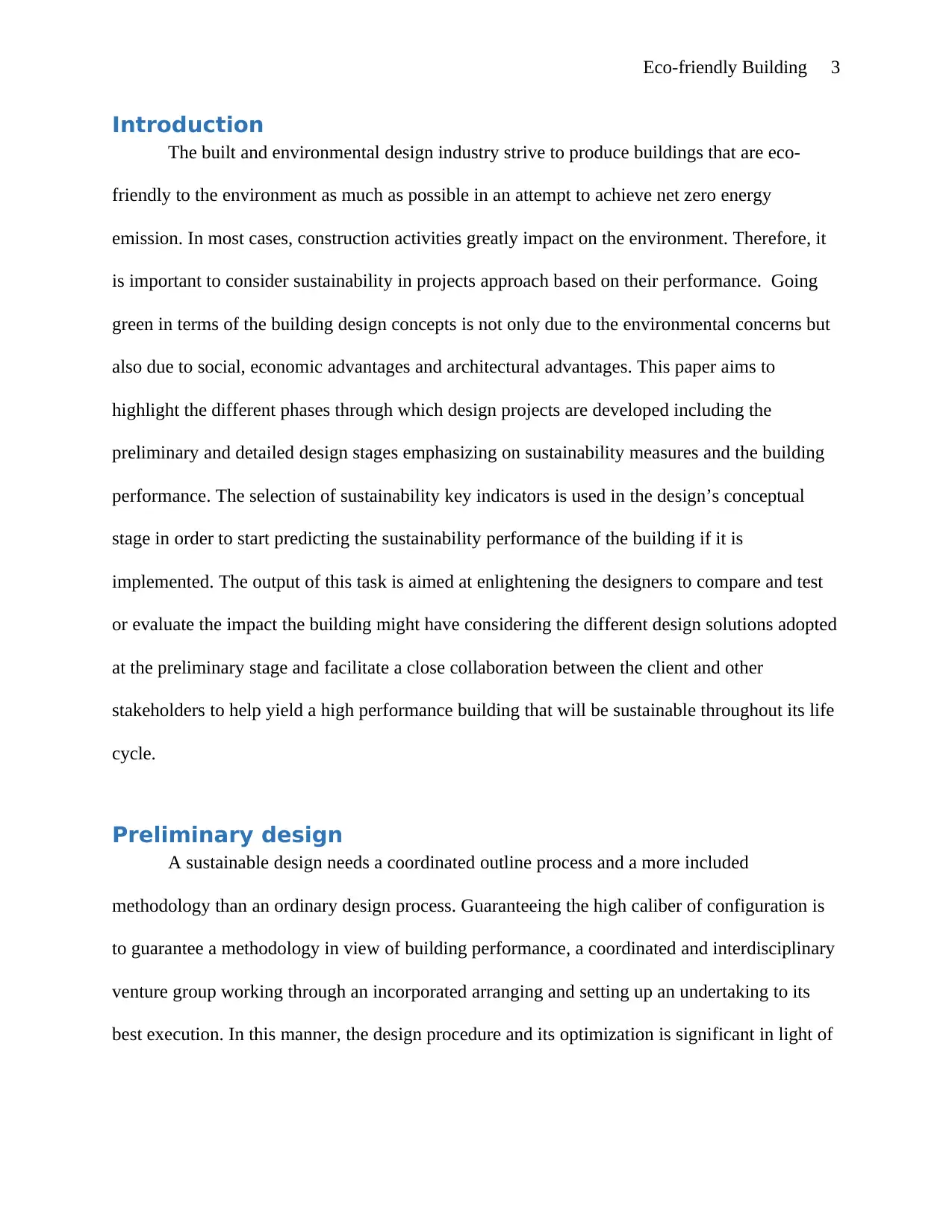
Eco-friendly Building 3
Introduction
The built and environmental design industry strive to produce buildings that are eco-
friendly to the environment as much as possible in an attempt to achieve net zero energy
emission. In most cases, construction activities greatly impact on the environment. Therefore, it
is important to consider sustainability in projects approach based on their performance. Going
green in terms of the building design concepts is not only due to the environmental concerns but
also due to social, economic advantages and architectural advantages. This paper aims to
highlight the different phases through which design projects are developed including the
preliminary and detailed design stages emphasizing on sustainability measures and the building
performance. The selection of sustainability key indicators is used in the design’s conceptual
stage in order to start predicting the sustainability performance of the building if it is
implemented. The output of this task is aimed at enlightening the designers to compare and test
or evaluate the impact the building might have considering the different design solutions adopted
at the preliminary stage and facilitate a close collaboration between the client and other
stakeholders to help yield a high performance building that will be sustainable throughout its life
cycle.
Preliminary design
A sustainable design needs a coordinated outline process and a more included
methodology than an ordinary design process. Guaranteeing the high caliber of configuration is
to guarantee a methodology in view of building performance, a coordinated and interdisciplinary
venture group working through an incorporated arranging and setting up an undertaking to its
best execution. In this manner, the design procedure and its optimization is significant in light of
Introduction
The built and environmental design industry strive to produce buildings that are eco-
friendly to the environment as much as possible in an attempt to achieve net zero energy
emission. In most cases, construction activities greatly impact on the environment. Therefore, it
is important to consider sustainability in projects approach based on their performance. Going
green in terms of the building design concepts is not only due to the environmental concerns but
also due to social, economic advantages and architectural advantages. This paper aims to
highlight the different phases through which design projects are developed including the
preliminary and detailed design stages emphasizing on sustainability measures and the building
performance. The selection of sustainability key indicators is used in the design’s conceptual
stage in order to start predicting the sustainability performance of the building if it is
implemented. The output of this task is aimed at enlightening the designers to compare and test
or evaluate the impact the building might have considering the different design solutions adopted
at the preliminary stage and facilitate a close collaboration between the client and other
stakeholders to help yield a high performance building that will be sustainable throughout its life
cycle.
Preliminary design
A sustainable design needs a coordinated outline process and a more included
methodology than an ordinary design process. Guaranteeing the high caliber of configuration is
to guarantee a methodology in view of building performance, a coordinated and interdisciplinary
venture group working through an incorporated arranging and setting up an undertaking to its
best execution. In this manner, the design procedure and its optimization is significant in light of
You're viewing a preview
Unlock full access by subscribing today!

Eco-friendly Building 4
the fact that most choices that will determine the building performance will be executed at this
stage.
A building project is created in stages. The idea of design stages is identified with an
arrangement of sequential activities that aides the development procedure. These activities are
gathered in stages by their level of need, shaping the design in each stage of the design process
(Araújo, et al., 2013). It is vital to think about the estimation of each activity/objective,
anticipating its significance on structures performance and its impact on the project cost keeping
in mind the end goal to actualize everything at the sufficient moment.
The project begins with the definition of its objectives and where the client meets the task
group and uncovered the objectives for the building. Amid this underlying stage, client and
configuration group share ideas trying to build up the building's philosophy and concept. The
building regulation standards is required to characterize key necessities and limitations towards
the project’s quality (Bragança & Mateus, 2012). The type of architecture and the functional
requirements of the building are discussed including the outdoor and indoor qualities admired by
the client. The site condition should be addressed to determine its suitability in construction. The
buildings orientation, spatial performance, energy requirements, space functions, comfort
practices are also tabled (Bragança & Mateus, 2012).
In addition concerns on building use, warming, cooling, lighting, ventilation, wastes,
water, site works, and materials are addressed. Moreover, it is at this phase that procurement
phase, undertaking and supportability methods, building plan life time, hierarchical structure,
project cost, maintenance and timescale are managed.
the fact that most choices that will determine the building performance will be executed at this
stage.
A building project is created in stages. The idea of design stages is identified with an
arrangement of sequential activities that aides the development procedure. These activities are
gathered in stages by their level of need, shaping the design in each stage of the design process
(Araújo, et al., 2013). It is vital to think about the estimation of each activity/objective,
anticipating its significance on structures performance and its impact on the project cost keeping
in mind the end goal to actualize everything at the sufficient moment.
The project begins with the definition of its objectives and where the client meets the task
group and uncovered the objectives for the building. Amid this underlying stage, client and
configuration group share ideas trying to build up the building's philosophy and concept. The
building regulation standards is required to characterize key necessities and limitations towards
the project’s quality (Bragança & Mateus, 2012). The type of architecture and the functional
requirements of the building are discussed including the outdoor and indoor qualities admired by
the client. The site condition should be addressed to determine its suitability in construction. The
buildings orientation, spatial performance, energy requirements, space functions, comfort
practices are also tabled (Bragança & Mateus, 2012).
In addition concerns on building use, warming, cooling, lighting, ventilation, wastes,
water, site works, and materials are addressed. Moreover, it is at this phase that procurement
phase, undertaking and supportability methods, building plan life time, hierarchical structure,
project cost, maintenance and timescale are managed.
Paraphrase This Document
Need a fresh take? Get an instant paraphrase of this document with our AI Paraphraser
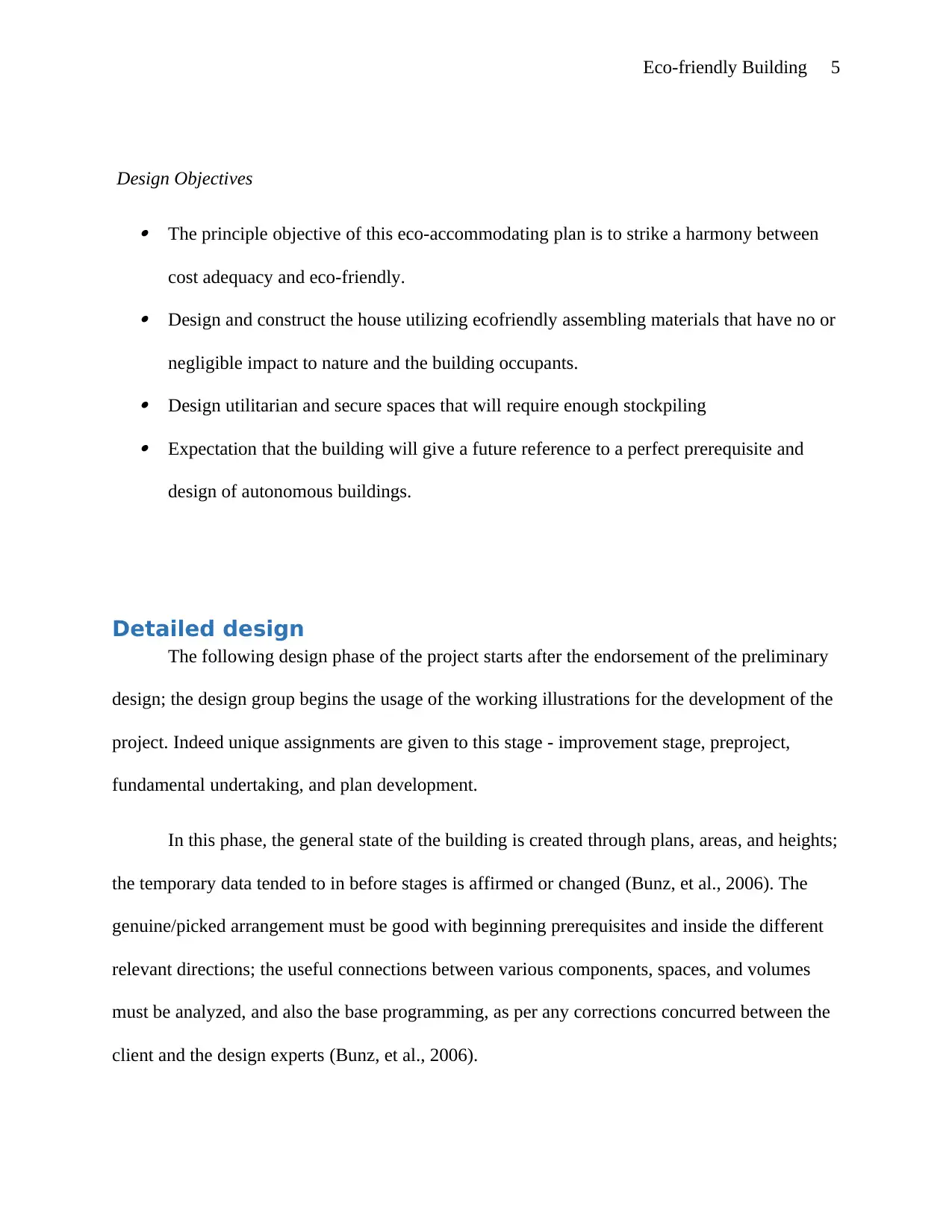
Eco-friendly Building 5
Design Objectives
The principle objective of this eco-accommodating plan is to strike a harmony between
cost adequacy and eco-friendly. Design and construct the house utilizing ecofriendly assembling materials that have no or
negligible impact to nature and the building occupants. Design utilitarian and secure spaces that will require enough stockpiling Expectation that the building will give a future reference to a perfect prerequisite and
design of autonomous buildings.
Detailed design
The following design phase of the project starts after the endorsement of the preliminary
design; the design group begins the usage of the working illustrations for the development of the
project. Indeed unique assignments are given to this stage - improvement stage, preproject,
fundamental undertaking, and plan development.
In this phase, the general state of the building is created through plans, areas, and heights;
the temporary data tended to in before stages is affirmed or changed (Bunz, et al., 2006). The
genuine/picked arrangement must be good with beginning prerequisites and inside the different
relevant directions; the useful connections between various components, spaces, and volumes
must be analyzed, and also the base programming, as per any corrections concurred between the
client and the design experts (Bunz, et al., 2006).
Design Objectives
The principle objective of this eco-accommodating plan is to strike a harmony between
cost adequacy and eco-friendly. Design and construct the house utilizing ecofriendly assembling materials that have no or
negligible impact to nature and the building occupants. Design utilitarian and secure spaces that will require enough stockpiling Expectation that the building will give a future reference to a perfect prerequisite and
design of autonomous buildings.
Detailed design
The following design phase of the project starts after the endorsement of the preliminary
design; the design group begins the usage of the working illustrations for the development of the
project. Indeed unique assignments are given to this stage - improvement stage, preproject,
fundamental undertaking, and plan development.
In this phase, the general state of the building is created through plans, areas, and heights;
the temporary data tended to in before stages is affirmed or changed (Bunz, et al., 2006). The
genuine/picked arrangement must be good with beginning prerequisites and inside the different
relevant directions; the useful connections between various components, spaces, and volumes
must be analyzed, and also the base programming, as per any corrections concurred between the
client and the design experts (Bunz, et al., 2006).
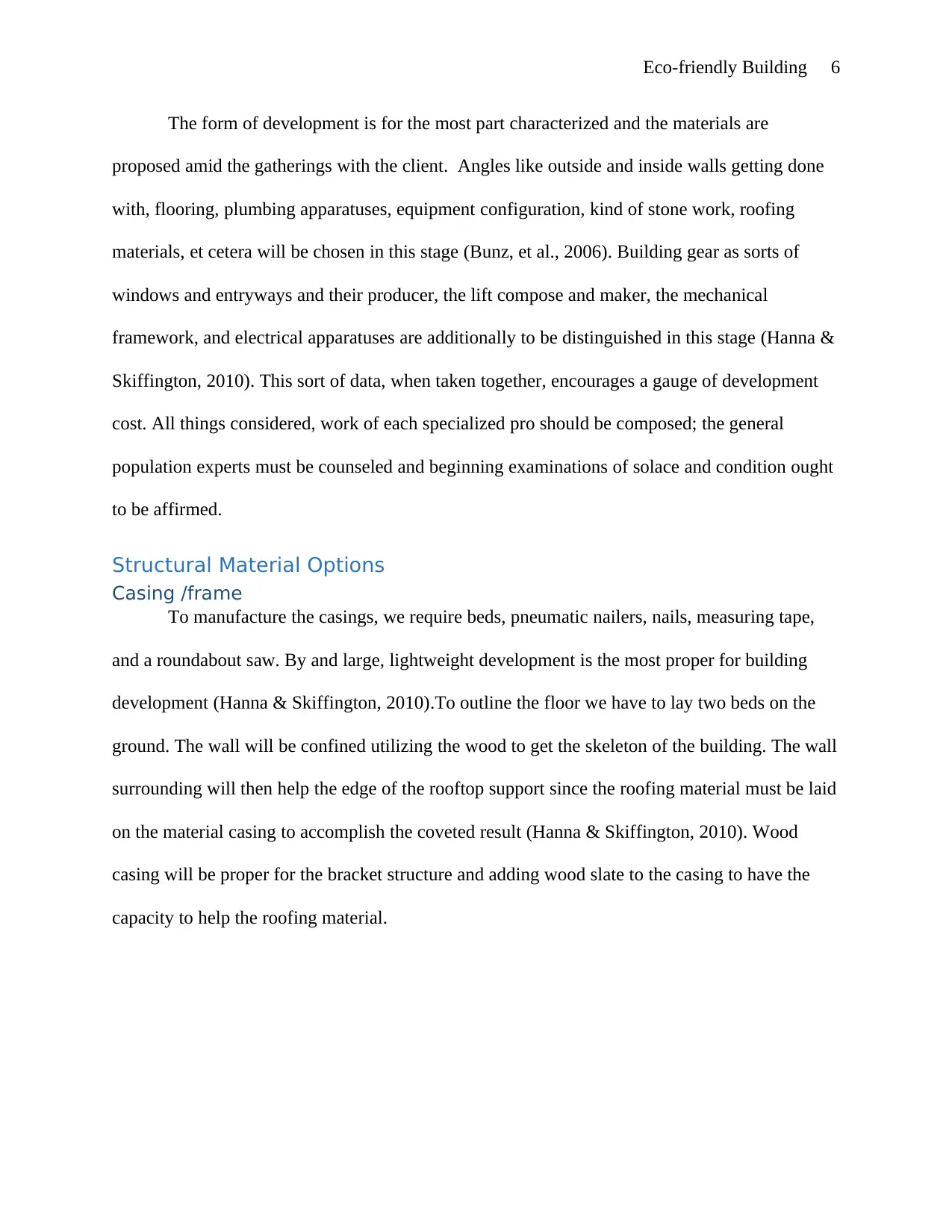
Eco-friendly Building 6
The form of development is for the most part characterized and the materials are
proposed amid the gatherings with the client. Angles like outside and inside walls getting done
with, flooring, plumbing apparatuses, equipment configuration, kind of stone work, roofing
materials, et cetera will be chosen in this stage (Bunz, et al., 2006). Building gear as sorts of
windows and entryways and their producer, the lift compose and maker, the mechanical
framework, and electrical apparatuses are additionally to be distinguished in this stage (Hanna &
Skiffington, 2010). This sort of data, when taken together, encourages a gauge of development
cost. All things considered, work of each specialized pro should be composed; the general
population experts must be counseled and beginning examinations of solace and condition ought
to be affirmed.
Structural Material Options
Casing /frame
To manufacture the casings, we require beds, pneumatic nailers, nails, measuring tape,
and a roundabout saw. By and large, lightweight development is the most proper for building
development (Hanna & Skiffington, 2010).To outline the floor we have to lay two beds on the
ground. The wall will be confined utilizing the wood to get the skeleton of the building. The wall
surrounding will then help the edge of the rooftop support since the roofing material must be laid
on the material casing to accomplish the coveted result (Hanna & Skiffington, 2010). Wood
casing will be proper for the bracket structure and adding wood slate to the casing to have the
capacity to help the roofing material.
The form of development is for the most part characterized and the materials are
proposed amid the gatherings with the client. Angles like outside and inside walls getting done
with, flooring, plumbing apparatuses, equipment configuration, kind of stone work, roofing
materials, et cetera will be chosen in this stage (Bunz, et al., 2006). Building gear as sorts of
windows and entryways and their producer, the lift compose and maker, the mechanical
framework, and electrical apparatuses are additionally to be distinguished in this stage (Hanna &
Skiffington, 2010). This sort of data, when taken together, encourages a gauge of development
cost. All things considered, work of each specialized pro should be composed; the general
population experts must be counseled and beginning examinations of solace and condition ought
to be affirmed.
Structural Material Options
Casing /frame
To manufacture the casings, we require beds, pneumatic nailers, nails, measuring tape,
and a roundabout saw. By and large, lightweight development is the most proper for building
development (Hanna & Skiffington, 2010).To outline the floor we have to lay two beds on the
ground. The wall will be confined utilizing the wood to get the skeleton of the building. The wall
surrounding will then help the edge of the rooftop support since the roofing material must be laid
on the material casing to accomplish the coveted result (Hanna & Skiffington, 2010). Wood
casing will be proper for the bracket structure and adding wood slate to the casing to have the
capacity to help the roofing material.
You're viewing a preview
Unlock full access by subscribing today!

Eco-friendly Building 7
Walls
The favored material for wall development will be square timber board due to its natural
advantages. Timber are from an inexhaustible source, economically sourced, non-lethal amid its
utilization, is low in typified carbon, warm spanning, low waste rates, fitting forever length,
adaptable and versatile (Mateus & Bragança, 2011). The timber boards will be lime rendered in
white to help in mirroring any overabundance warm from the sunrays. From a manageable
perspective, timber is an inexhaustible building material ready to ingest carbon from the air, and
this makes it ready to support the life of the building (Haroglu, et al., 2009). Nonetheless, timber
utilized ought to be dealt with from termites and since the temperature in Barrington is chilly, the
timber utilized ought to be free from molds and any sort of decay.
Roof
It is critical to consider the correct roofing material considering the precipitation design.
The principal thought ought to be a material that is waterproof, natural amicable, moderate,
charming, and tough. The best material to be utilized in material the shed is cedar shingles
produced using pine, cedar, redwood, or the western red cedar. In any case, take note of that
rooftop shingles are not imperviousness to fire and ought to be treated with fire resistant to keep
any type of flame mishap (Bunz, et al., 2006). On the opposite side, wood shingles are outwardly
engaging, high level of warm protection, have low carbon impression, and are produced using a
characteristic source that is inexhaustible. To introduce the cedar shingles, we will initially have
the material felt lying on the rafters to accomplish the coveted quality wrap up. The upper room
space will likewise be high to give more space for air dissemination that can result into the stack
impact in the room.
Walls
The favored material for wall development will be square timber board due to its natural
advantages. Timber are from an inexhaustible source, economically sourced, non-lethal amid its
utilization, is low in typified carbon, warm spanning, low waste rates, fitting forever length,
adaptable and versatile (Mateus & Bragança, 2011). The timber boards will be lime rendered in
white to help in mirroring any overabundance warm from the sunrays. From a manageable
perspective, timber is an inexhaustible building material ready to ingest carbon from the air, and
this makes it ready to support the life of the building (Haroglu, et al., 2009). Nonetheless, timber
utilized ought to be dealt with from termites and since the temperature in Barrington is chilly, the
timber utilized ought to be free from molds and any sort of decay.
Roof
It is critical to consider the correct roofing material considering the precipitation design.
The principal thought ought to be a material that is waterproof, natural amicable, moderate,
charming, and tough. The best material to be utilized in material the shed is cedar shingles
produced using pine, cedar, redwood, or the western red cedar. In any case, take note of that
rooftop shingles are not imperviousness to fire and ought to be treated with fire resistant to keep
any type of flame mishap (Bunz, et al., 2006). On the opposite side, wood shingles are outwardly
engaging, high level of warm protection, have low carbon impression, and are produced using a
characteristic source that is inexhaustible. To introduce the cedar shingles, we will initially have
the material felt lying on the rafters to accomplish the coveted quality wrap up. The upper room
space will likewise be high to give more space for air dissemination that can result into the stack
impact in the room.
Paraphrase This Document
Need a fresh take? Get an instant paraphrase of this document with our AI Paraphraser
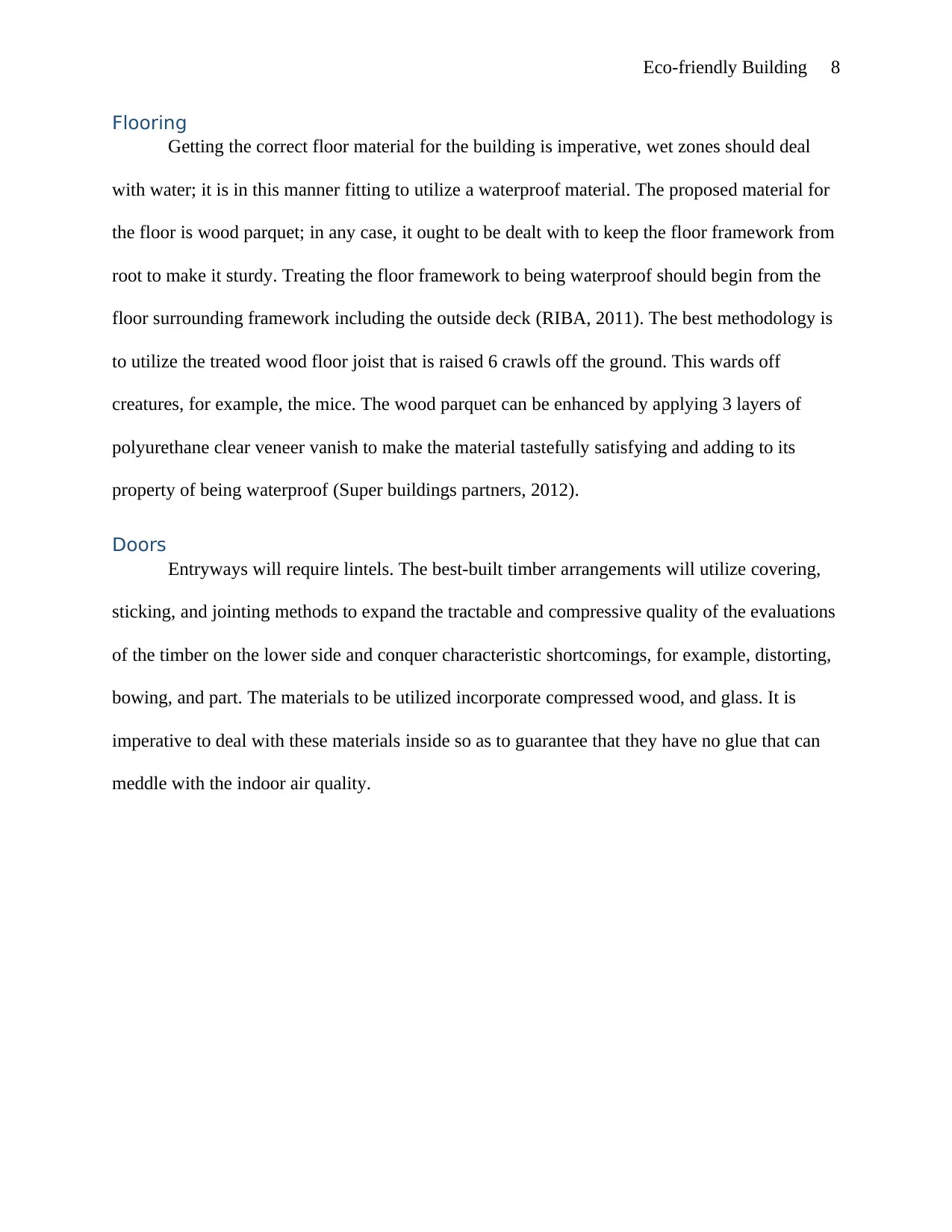
Eco-friendly Building 8
Flooring
Getting the correct floor material for the building is imperative, wet zones should deal
with water; it is in this manner fitting to utilize a waterproof material. The proposed material for
the floor is wood parquet; in any case, it ought to be dealt with to keep the floor framework from
root to make it sturdy. Treating the floor framework to being waterproof should begin from the
floor surrounding framework including the outside deck (RIBA, 2011). The best methodology is
to utilize the treated wood floor joist that is raised 6 crawls off the ground. This wards off
creatures, for example, the mice. The wood parquet can be enhanced by applying 3 layers of
polyurethane clear veneer vanish to make the material tastefully satisfying and adding to its
property of being waterproof (Super buildings partners, 2012).
Doors
Entryways will require lintels. The best-built timber arrangements will utilize covering,
sticking, and jointing methods to expand the tractable and compressive quality of the evaluations
of the timber on the lower side and conquer characteristic shortcomings, for example, distorting,
bowing, and part. The materials to be utilized incorporate compressed wood, and glass. It is
imperative to deal with these materials inside so as to guarantee that they have no glue that can
meddle with the indoor air quality.
Flooring
Getting the correct floor material for the building is imperative, wet zones should deal
with water; it is in this manner fitting to utilize a waterproof material. The proposed material for
the floor is wood parquet; in any case, it ought to be dealt with to keep the floor framework from
root to make it sturdy. Treating the floor framework to being waterproof should begin from the
floor surrounding framework including the outside deck (RIBA, 2011). The best methodology is
to utilize the treated wood floor joist that is raised 6 crawls off the ground. This wards off
creatures, for example, the mice. The wood parquet can be enhanced by applying 3 layers of
polyurethane clear veneer vanish to make the material tastefully satisfying and adding to its
property of being waterproof (Super buildings partners, 2012).
Doors
Entryways will require lintels. The best-built timber arrangements will utilize covering,
sticking, and jointing methods to expand the tractable and compressive quality of the evaluations
of the timber on the lower side and conquer characteristic shortcomings, for example, distorting,
bowing, and part. The materials to be utilized incorporate compressed wood, and glass. It is
imperative to deal with these materials inside so as to guarantee that they have no glue that can
meddle with the indoor air quality.
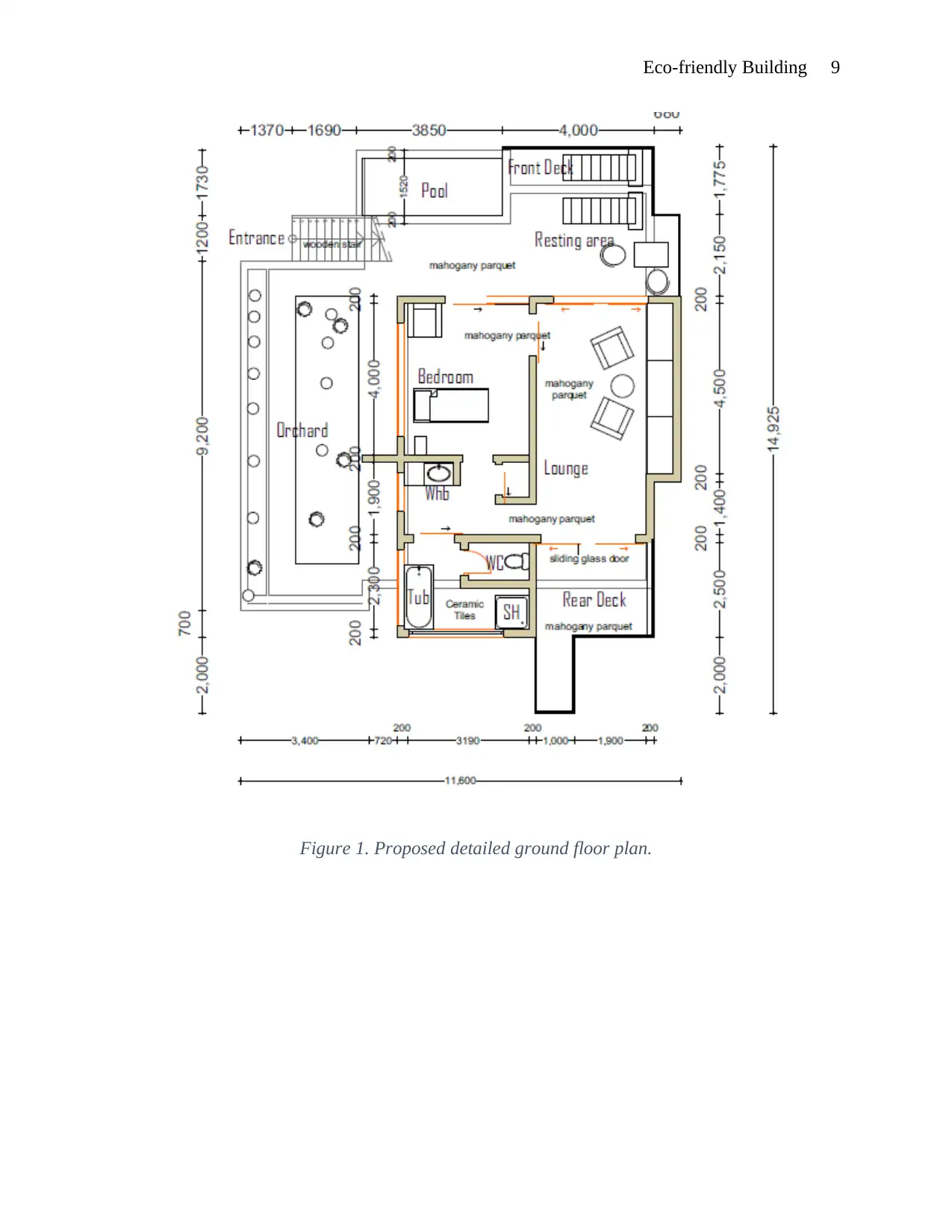
Eco-friendly Building 9
Figure 1. Proposed detailed ground floor plan.
Figure 1. Proposed detailed ground floor plan.
You're viewing a preview
Unlock full access by subscribing today!
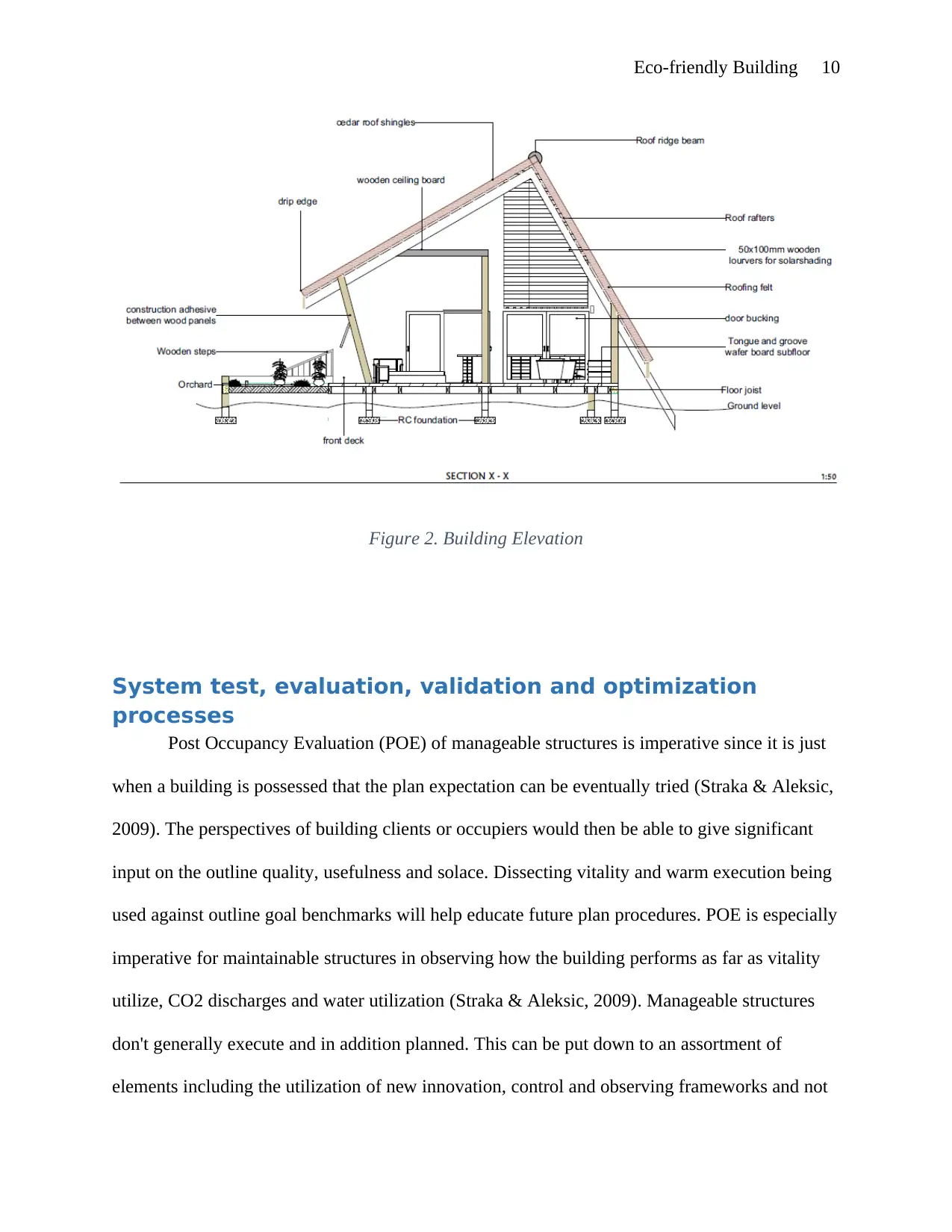
Eco-friendly Building 10
Figure 2. Building Elevation
System test, evaluation, validation and optimization
processes
Post Occupancy Evaluation (POE) of manageable structures is imperative since it is just
when a building is possessed that the plan expectation can be eventually tried (Straka & Aleksic,
2009). The perspectives of building clients or occupiers would then be able to give significant
input on the outline quality, usefulness and solace. Dissecting vitality and warm execution being
used against outline goal benchmarks will help educate future plan procedures. POE is especially
imperative for maintainable structures in observing how the building performs as far as vitality
utilize, CO2 discharges and water utilization (Straka & Aleksic, 2009). Manageable structures
don't generally execute and in addition planned. This can be put down to an assortment of
elements including the utilization of new innovation, control and observing frameworks and not
Figure 2. Building Elevation
System test, evaluation, validation and optimization
processes
Post Occupancy Evaluation (POE) of manageable structures is imperative since it is just
when a building is possessed that the plan expectation can be eventually tried (Straka & Aleksic,
2009). The perspectives of building clients or occupiers would then be able to give significant
input on the outline quality, usefulness and solace. Dissecting vitality and warm execution being
used against outline goal benchmarks will help educate future plan procedures. POE is especially
imperative for maintainable structures in observing how the building performs as far as vitality
utilize, CO2 discharges and water utilization (Straka & Aleksic, 2009). Manageable structures
don't generally execute and in addition planned. This can be put down to an assortment of
elements including the utilization of new innovation, control and observing frameworks and not
Paraphrase This Document
Need a fresh take? Get an instant paraphrase of this document with our AI Paraphraser
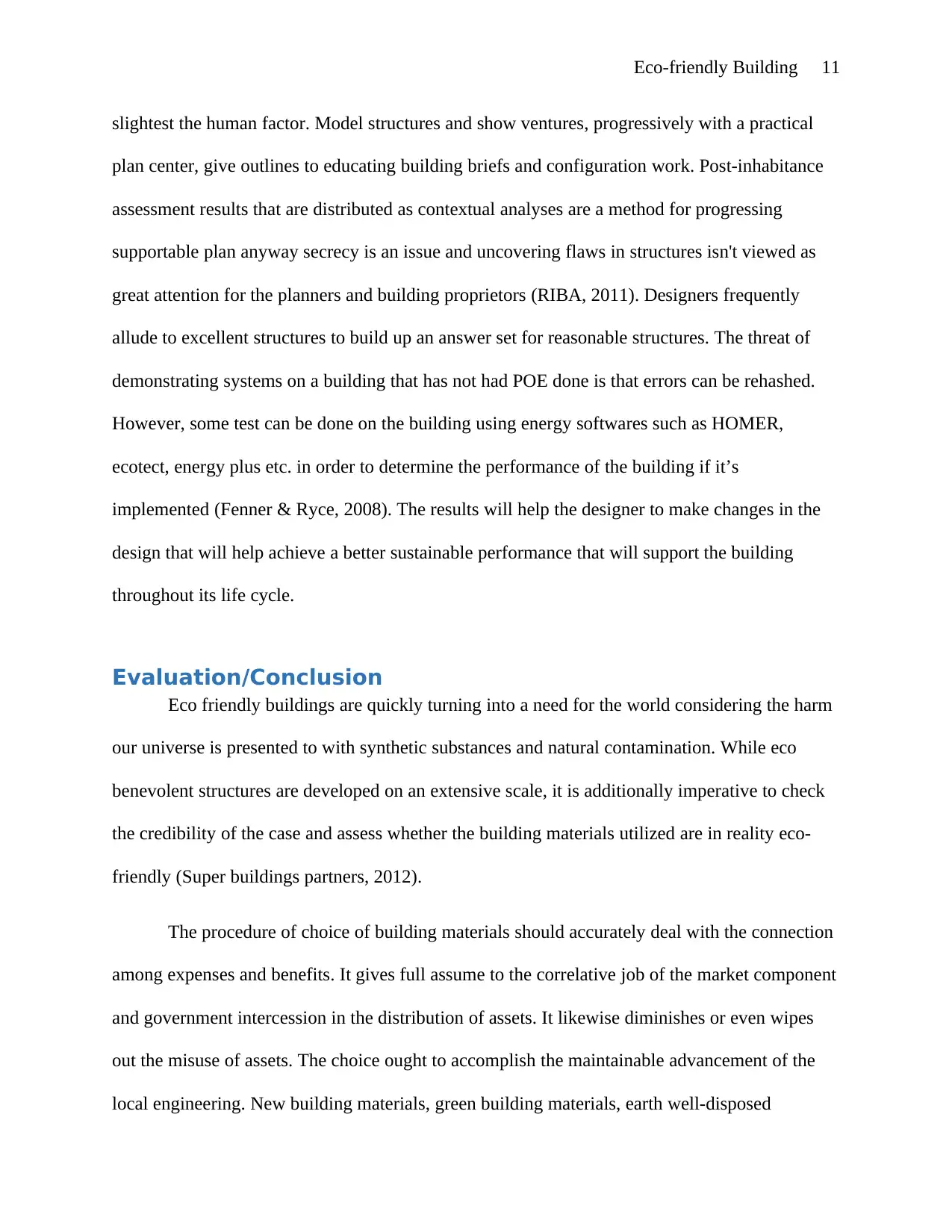
Eco-friendly Building 11
slightest the human factor. Model structures and show ventures, progressively with a practical
plan center, give outlines to educating building briefs and configuration work. Post-inhabitance
assessment results that are distributed as contextual analyses are a method for progressing
supportable plan anyway secrecy is an issue and uncovering flaws in structures isn't viewed as
great attention for the planners and building proprietors (RIBA, 2011). Designers frequently
allude to excellent structures to build up an answer set for reasonable structures. The threat of
demonstrating systems on a building that has not had POE done is that errors can be rehashed.
However, some test can be done on the building using energy softwares such as HOMER,
ecotect, energy plus etc. in order to determine the performance of the building if it’s
implemented (Fenner & Ryce, 2008). The results will help the designer to make changes in the
design that will help achieve a better sustainable performance that will support the building
throughout its life cycle.
Evaluation/Conclusion
Eco friendly buildings are quickly turning into a need for the world considering the harm
our universe is presented to with synthetic substances and natural contamination. While eco
benevolent structures are developed on an extensive scale, it is additionally imperative to check
the credibility of the case and assess whether the building materials utilized are in reality eco-
friendly (Super buildings partners, 2012).
The procedure of choice of building materials should accurately deal with the connection
among expenses and benefits. It gives full assume to the correlative job of the market component
and government intercession in the distribution of assets. It likewise diminishes or even wipes
out the misuse of assets. The choice ought to accomplish the maintainable advancement of the
local engineering. New building materials, green building materials, earth well-disposed
slightest the human factor. Model structures and show ventures, progressively with a practical
plan center, give outlines to educating building briefs and configuration work. Post-inhabitance
assessment results that are distributed as contextual analyses are a method for progressing
supportable plan anyway secrecy is an issue and uncovering flaws in structures isn't viewed as
great attention for the planners and building proprietors (RIBA, 2011). Designers frequently
allude to excellent structures to build up an answer set for reasonable structures. The threat of
demonstrating systems on a building that has not had POE done is that errors can be rehashed.
However, some test can be done on the building using energy softwares such as HOMER,
ecotect, energy plus etc. in order to determine the performance of the building if it’s
implemented (Fenner & Ryce, 2008). The results will help the designer to make changes in the
design that will help achieve a better sustainable performance that will support the building
throughout its life cycle.
Evaluation/Conclusion
Eco friendly buildings are quickly turning into a need for the world considering the harm
our universe is presented to with synthetic substances and natural contamination. While eco
benevolent structures are developed on an extensive scale, it is additionally imperative to check
the credibility of the case and assess whether the building materials utilized are in reality eco-
friendly (Super buildings partners, 2012).
The procedure of choice of building materials should accurately deal with the connection
among expenses and benefits. It gives full assume to the correlative job of the market component
and government intercession in the distribution of assets. It likewise diminishes or even wipes
out the misuse of assets. The choice ought to accomplish the maintainable advancement of the
local engineering. New building materials, green building materials, earth well-disposed
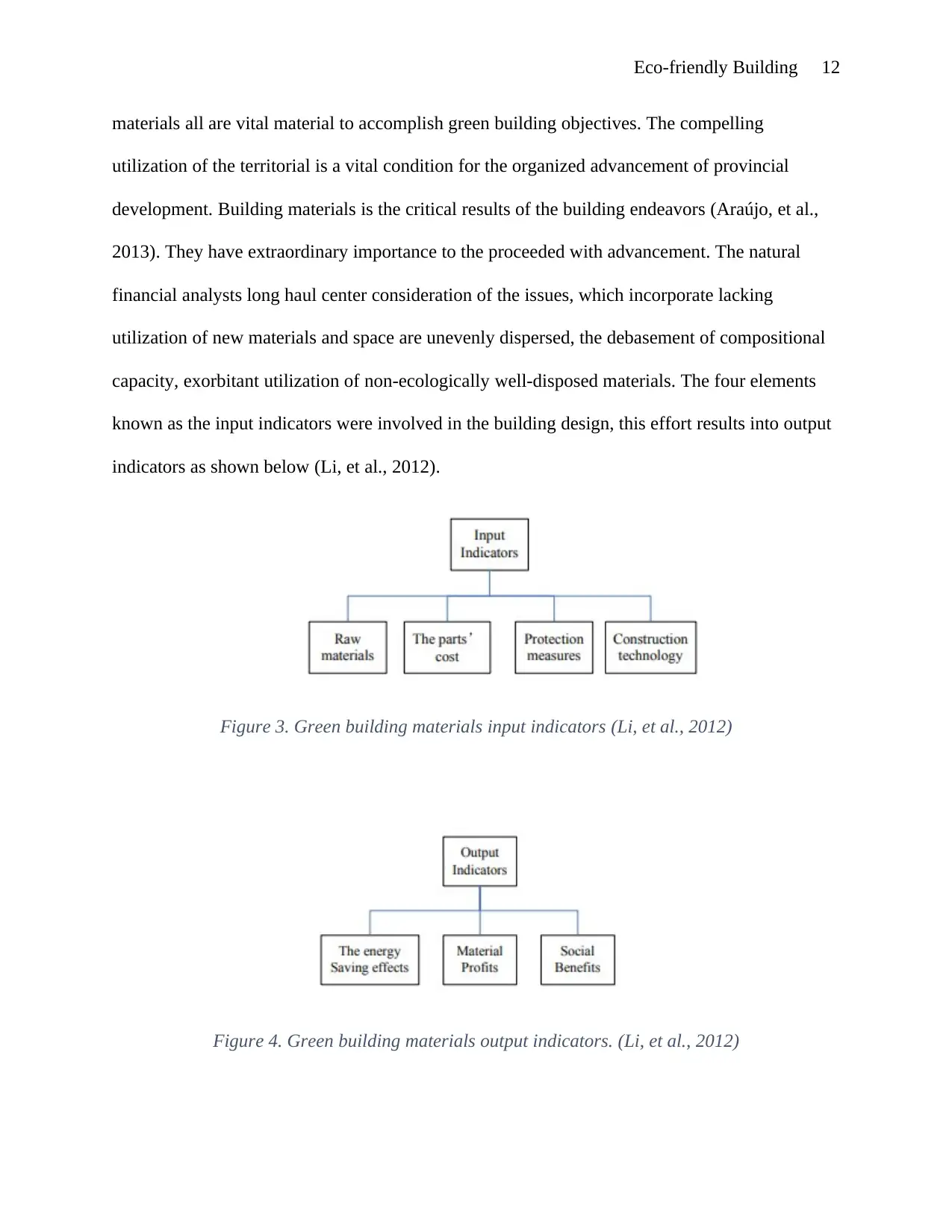
Eco-friendly Building 12
materials all are vital material to accomplish green building objectives. The compelling
utilization of the territorial is a vital condition for the organized advancement of provincial
development. Building materials is the critical results of the building endeavors (Araújo, et al.,
2013). They have extraordinary importance to the proceeded with advancement. The natural
financial analysts long haul center consideration of the issues, which incorporate lacking
utilization of new materials and space are unevenly dispersed, the debasement of compositional
capacity, exorbitant utilization of non-ecologically well-disposed materials. The four elements
known as the input indicators were involved in the building design, this effort results into output
indicators as shown below (Li, et al., 2012).
Figure 3. Green building materials input indicators (Li, et al., 2012)
Figure 4. Green building materials output indicators. (Li, et al., 2012)
materials all are vital material to accomplish green building objectives. The compelling
utilization of the territorial is a vital condition for the organized advancement of provincial
development. Building materials is the critical results of the building endeavors (Araújo, et al.,
2013). They have extraordinary importance to the proceeded with advancement. The natural
financial analysts long haul center consideration of the issues, which incorporate lacking
utilization of new materials and space are unevenly dispersed, the debasement of compositional
capacity, exorbitant utilization of non-ecologically well-disposed materials. The four elements
known as the input indicators were involved in the building design, this effort results into output
indicators as shown below (Li, et al., 2012).
Figure 3. Green building materials input indicators (Li, et al., 2012)
Figure 4. Green building materials output indicators. (Li, et al., 2012)
You're viewing a preview
Unlock full access by subscribing today!
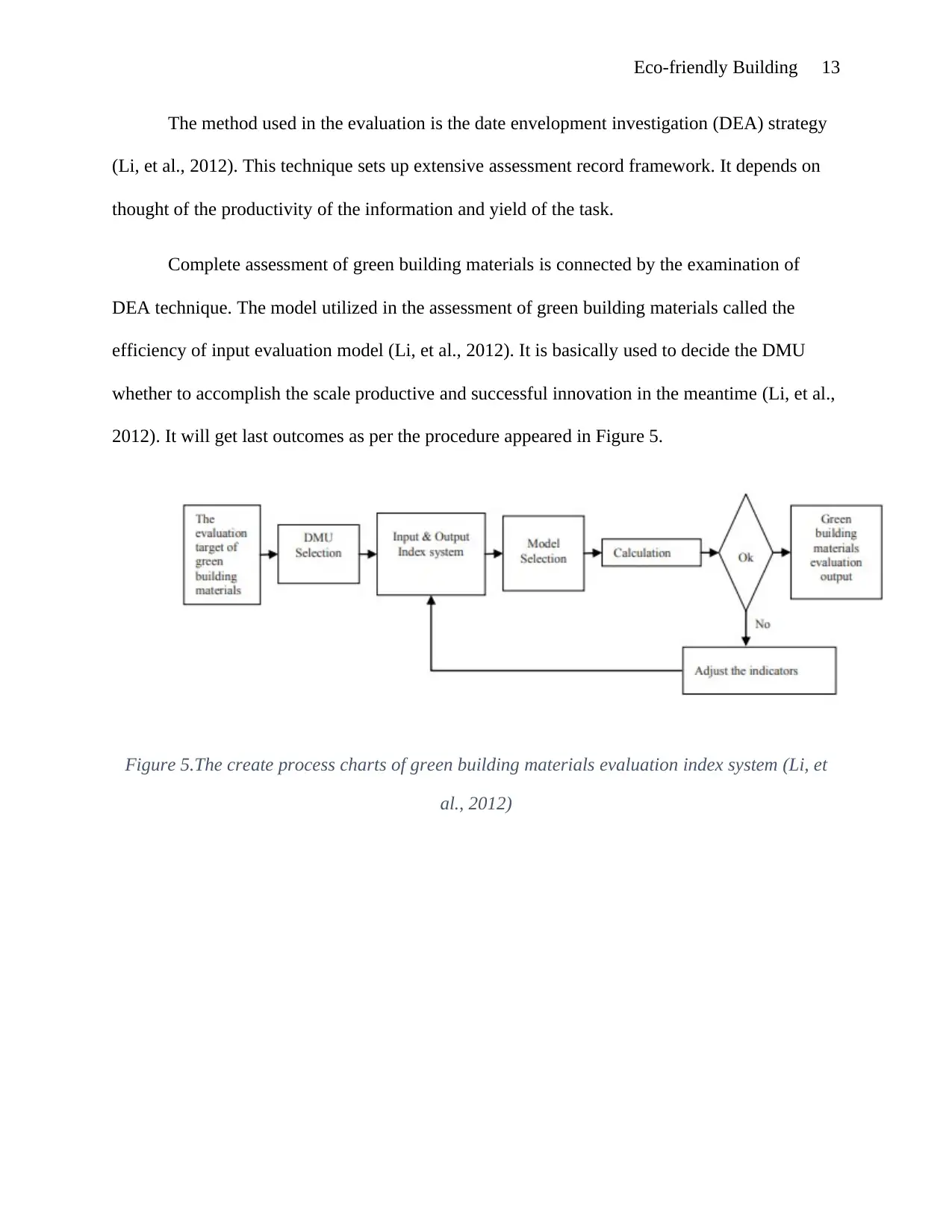
Eco-friendly Building 13
The method used in the evaluation is the date envelopment investigation (DEA) strategy
(Li, et al., 2012). This technique sets up extensive assessment record framework. It depends on
thought of the productivity of the information and yield of the task.
Complete assessment of green building materials is connected by the examination of
DEA technique. The model utilized in the assessment of green building materials called the
efficiency of input evaluation model (Li, et al., 2012). It is basically used to decide the DMU
whether to accomplish the scale productive and successful innovation in the meantime (Li, et al.,
2012). It will get last outcomes as per the procedure appeared in Figure 5.
Figure 5.The create process charts of green building materials evaluation index system (Li, et
al., 2012)
The method used in the evaluation is the date envelopment investigation (DEA) strategy
(Li, et al., 2012). This technique sets up extensive assessment record framework. It depends on
thought of the productivity of the information and yield of the task.
Complete assessment of green building materials is connected by the examination of
DEA technique. The model utilized in the assessment of green building materials called the
efficiency of input evaluation model (Li, et al., 2012). It is basically used to decide the DMU
whether to accomplish the scale productive and successful innovation in the meantime (Li, et al.,
2012). It will get last outcomes as per the procedure appeared in Figure 5.
Figure 5.The create process charts of green building materials evaluation index system (Li, et
al., 2012)
Paraphrase This Document
Need a fresh take? Get an instant paraphrase of this document with our AI Paraphraser
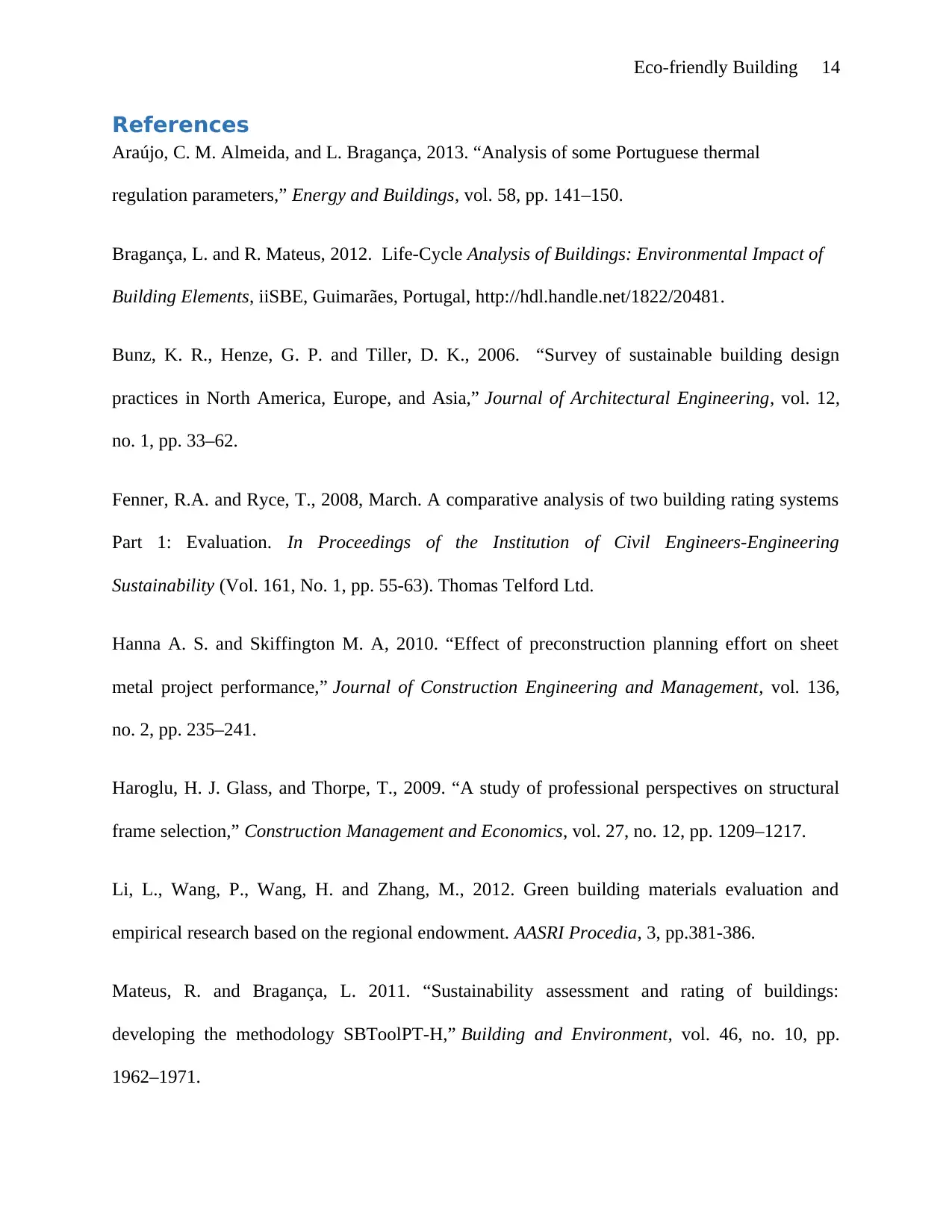
Eco-friendly Building 14
References
Araújo, C. M. Almeida, and L. Bragança, 2013. “Analysis of some Portuguese thermal
regulation parameters,” Energy and Buildings, vol. 58, pp. 141–150.
Bragança, L. and R. Mateus, 2012. Life-Cycle Analysis of Buildings: Environmental Impact of
Building Elements, iiSBE, Guimarães, Portugal, http://hdl.handle.net/1822/20481.
Bunz, K. R., Henze, G. P. and Tiller, D. K., 2006. “Survey of sustainable building design
practices in North America, Europe, and Asia,” Journal of Architectural Engineering, vol. 12,
no. 1, pp. 33–62.
Fenner, R.A. and Ryce, T., 2008, March. A comparative analysis of two building rating systems
Part 1: Evaluation. In Proceedings of the Institution of Civil Engineers-Engineering
Sustainability (Vol. 161, No. 1, pp. 55-63). Thomas Telford Ltd.
Hanna A. S. and Skiffington M. A, 2010. “Effect of preconstruction planning effort on sheet
metal project performance,” Journal of Construction Engineering and Management, vol. 136,
no. 2, pp. 235–241.
Haroglu, H. J. Glass, and Thorpe, T., 2009. “A study of professional perspectives on structural
frame selection,” Construction Management and Economics, vol. 27, no. 12, pp. 1209–1217.
Li, L., Wang, P., Wang, H. and Zhang, M., 2012. Green building materials evaluation and
empirical research based on the regional endowment. AASRI Procedia, 3, pp.381-386.
Mateus, R. and Bragança, L. 2011. “Sustainability assessment and rating of buildings:
developing the methodology SBToolPT-H,” Building and Environment, vol. 46, no. 10, pp.
1962–1971.
References
Araújo, C. M. Almeida, and L. Bragança, 2013. “Analysis of some Portuguese thermal
regulation parameters,” Energy and Buildings, vol. 58, pp. 141–150.
Bragança, L. and R. Mateus, 2012. Life-Cycle Analysis of Buildings: Environmental Impact of
Building Elements, iiSBE, Guimarães, Portugal, http://hdl.handle.net/1822/20481.
Bunz, K. R., Henze, G. P. and Tiller, D. K., 2006. “Survey of sustainable building design
practices in North America, Europe, and Asia,” Journal of Architectural Engineering, vol. 12,
no. 1, pp. 33–62.
Fenner, R.A. and Ryce, T., 2008, March. A comparative analysis of two building rating systems
Part 1: Evaluation. In Proceedings of the Institution of Civil Engineers-Engineering
Sustainability (Vol. 161, No. 1, pp. 55-63). Thomas Telford Ltd.
Hanna A. S. and Skiffington M. A, 2010. “Effect of preconstruction planning effort on sheet
metal project performance,” Journal of Construction Engineering and Management, vol. 136,
no. 2, pp. 235–241.
Haroglu, H. J. Glass, and Thorpe, T., 2009. “A study of professional perspectives on structural
frame selection,” Construction Management and Economics, vol. 27, no. 12, pp. 1209–1217.
Li, L., Wang, P., Wang, H. and Zhang, M., 2012. Green building materials evaluation and
empirical research based on the regional endowment. AASRI Procedia, 3, pp.381-386.
Mateus, R. and Bragança, L. 2011. “Sustainability assessment and rating of buildings:
developing the methodology SBToolPT-H,” Building and Environment, vol. 46, no. 10, pp.
1962–1971.
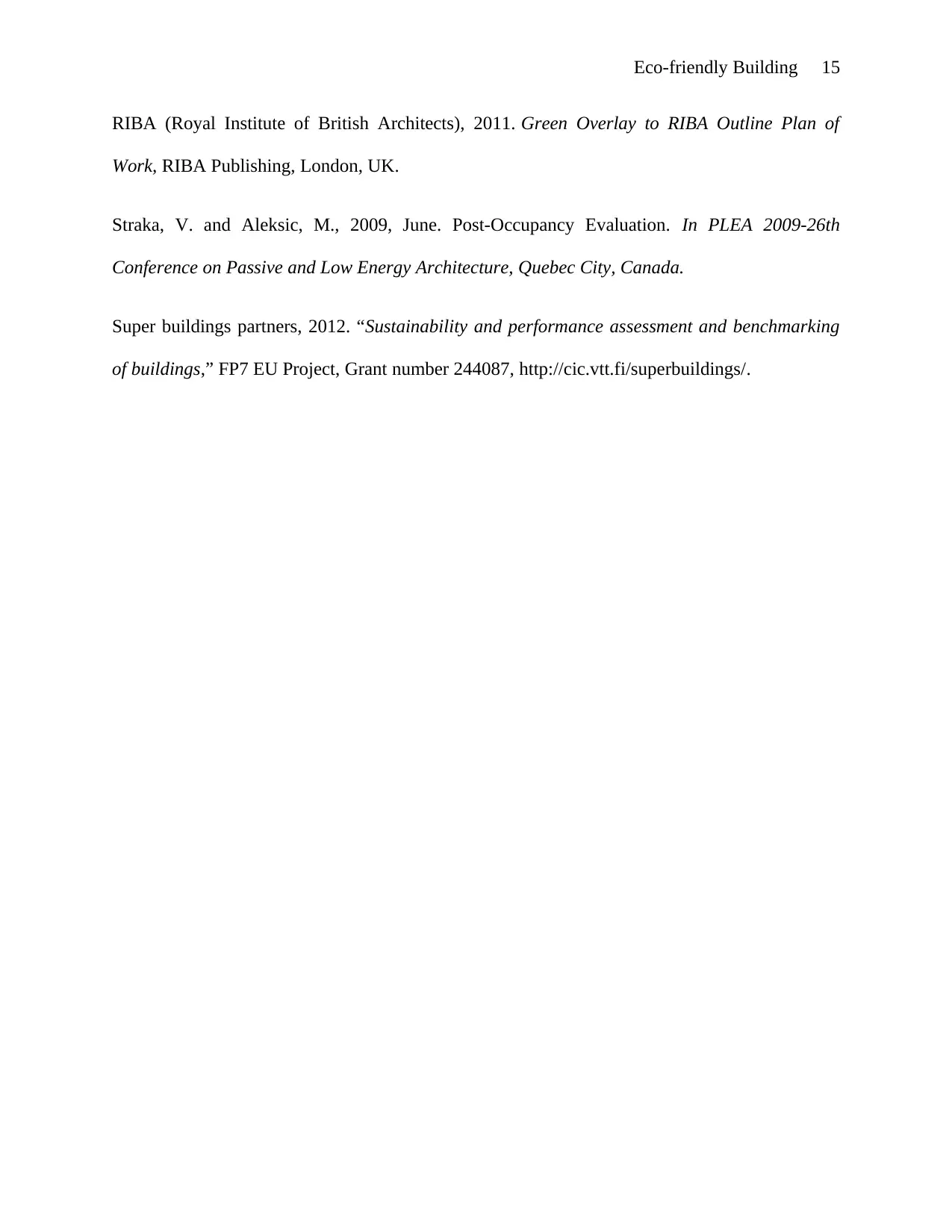
Eco-friendly Building 15
RIBA (Royal Institute of British Architects), 2011. Green Overlay to RIBA Outline Plan of
Work, RIBA Publishing, London, UK.
Straka, V. and Aleksic, M., 2009, June. Post-Occupancy Evaluation. In PLEA 2009-26th
Conference on Passive and Low Energy Architecture, Quebec City, Canada.
Super buildings partners, 2012. “Sustainability and performance assessment and benchmarking
of buildings,” FP7 EU Project, Grant number 244087, http://cic.vtt.fi/superbuildings/.
RIBA (Royal Institute of British Architects), 2011. Green Overlay to RIBA Outline Plan of
Work, RIBA Publishing, London, UK.
Straka, V. and Aleksic, M., 2009, June. Post-Occupancy Evaluation. In PLEA 2009-26th
Conference on Passive and Low Energy Architecture, Quebec City, Canada.
Super buildings partners, 2012. “Sustainability and performance assessment and benchmarking
of buildings,” FP7 EU Project, Grant number 244087, http://cic.vtt.fi/superbuildings/.
You're viewing a preview
Unlock full access by subscribing today!
1 out of 15
Related Documents
Your All-in-One AI-Powered Toolkit for Academic Success.
+13062052269
info@desklib.com
Available 24*7 on WhatsApp / Email
![[object Object]](/_next/static/media/star-bottom.7253800d.svg)
Unlock your academic potential
© 2024 | Zucol Services PVT LTD | All rights reserved.





